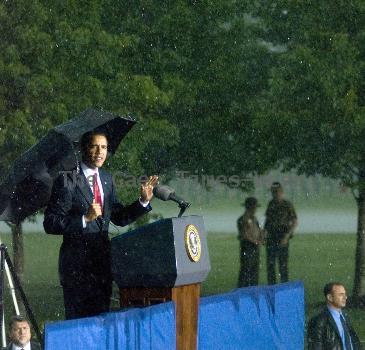Cap collects some of the Gulf oil gusher, unclear how much; should know later Fri.
By Greg Bluestein, APFriday, June 4, 2010
Cap collecting Gulf oil, still unclear how much
GRAND ISLE, La. — A cap collected some of the oil spewing out of the blown-out Gulf well, but black crude was still leaking into the sea, and officials said they won’t know until later Friday how the device is working.
It’s the latest bid to contain — not plug — the nation’s worst spill. Even if the cap is successful, it will not collect all the oil coming out. Stopping the leak is still months away.
But officials were optimistic when the inverted funnel-like system, wrapped in hoses and more sophisticated than previous devices, started pumping oil and gas to a tanker on the surface.
Coast Guard Adm. Thad Allen, the government’s point man for the disaster, said a very rough estimate of current collection would be about 42,000 gallons a day, though he stressed he wasn’t certain.
“Progress is being made, but we need to caution against over-optimism,” he said.
President Barack Obama was set to visit the Louisiana coast Friday, his second trip in a week and the third since the disaster unfolded following an April 20 oil rig explosion. Eleven workers were killed.
Meanwhile, waves of gooey tar blobs were washing ashore on the white sand of the Florida Panhandle and nearby Alabama beaches as a slick from the spill moved closer to shore.
Spotters who had been seeing a few tar balls in recent days found a substantially larger number before dawn on the beaches of the Gulf Islands National Seashore and nearby areas, a county emergency official said. The park is a long string of connected barrier islands near Pensacola.
BP’s Chief Operating Officer Doug Suttles said it will be later in the day before they know how much is being captured.
“There is flow coming up the pipe. Just now, I don’t know the exact rate,” Suttles said on NBC’s “Today” show.
Robots a mile beneath the Gulf positioned the lid over the main pipe on the leaking well Thursday night. The robots were shot chemical dispersants — though it looked more like flares when illuminated a mile underwater — at the spewing oil.
To put the cap in place, BP had to slice off the pipe with giant shears after a diamond-edged saw became stuck. By doing so, they risked increasing the flow by as much as 20 percent, though Allen said it was still too soon know whether that had happened.
“Once the containment cap is on and it’s working, we hope the rate is significantly reduced,” he said.
The jagged cut forced crews to use a looser fitting cap, but Allen did not rule out trying to again smooth out the cut with the diamond saw if officials aren’t satisfied with the current cap.
Suttles said some of the oil still pouring out came from vents deliberately placed to keep icelike crystals from forming that could block the funnel. BP will try to close those four vents in succession and reduce the spill, he said.
The best chance to plug the leak is a pair of relief wells, which are at least two months away. The well has spit out between 21 million and 46 million gallons of oil since a rig exploded on April 20 about 50 miles from the Louisiana coast, killing 11 workers. BP was leasing the rig and is responsible to fix and clean up the spill.
In oil-soaked Grand Isle, Jason French might as well have painted a bulls-eye on his back. His mission was to be BP’s representative at a meeting for 50 or so residents who had gathered at a church to vent.
“We are all angry and frustrated,” he said. “Feel free tonight to let me see that anger. Direct it at me, direct it at BP, but I want to assure you, the folks in this community, that we are working hard to remedy the situation.”
Residents weren’t buying it.
“Sorry doesn’t pay the bills,” said Susan Felio Price, a longtime resident.
“Through the negligence of BP we now find ourselves trying to roller-skate up a mountain,” she said. “We’re growing really weary. We’re tired. We’re sick and tired of being sick and tired. Someone’s got to help us get to the top of that mountain.”
Obama shared some of that anger ahead of his Gulf visit. He told CNN’s Larry King that he was frustrated and used his strongest language in assailing BP.
“I am furious at this entire situation because this is an example where somebody didn’t think through the consequences of their actions,” Obama said. “This is imperiling an entire way of life and an entire region for potentially years.”
Meanwhile, newly disclosed internal Coast Guard documents from the day after the explosion aboard the Deepwater Horizon rig indicated that U.S. officials were warning of a leak of 336,000 gallons per day of crude from the well in the event of a complete blowout.
The volume turned out to be much closer to that figure than the 42,000 gallons per day that BP first estimated. Weeks later it was revised to 210,000 gallons. Now, an estimated 500,000 to 1 million gallons of crude is believed to be leaking daily.
The Center for Public Integrity, which initially reported the Coast Guard logs, said it obtained them from Rep. Darrell Issa, R-Calif., ranking Republican on the House Oversight and Government Reform Committee.
The logs also showed early in the disaster that remote underwater robots were unable to activate the rig’s blowout preventer, which was supposed to shut off the flow from the well in the event of such a catastrophic failure.
The damage to the environment was chilling on East Grand Terre Island along the Louisiana coast, where workers found birds coated in thick, black goo. Images shot by an Associated Press photographer show Brown pelicans drenched in thick oil, struggling and flailing in the surf.
BP CEO Tony Hayward promised that the company would clean up every drop of oil and “restore the shoreline to its original state.”
“BP will be here for a very long time. We realize this is just the beginning,” he said.
Those on Grand Isle seemed less than convinced by BP’s assurances.
“We want you to feel what we feel,” said Leoda Bladsacker, a member of the town’s council, as her voice trembled. “We’re not going to be OK for a long, long time.”
Associated Press writers Eileen Sullivan in Washington and Paul J. Weber in Houston contributed to this report.
Tags: Accidents, Barack Obama, Coastlines And Beaches, Environmental Concerns, Grand Isle, Louisiana, Military Technology, North America, United States



